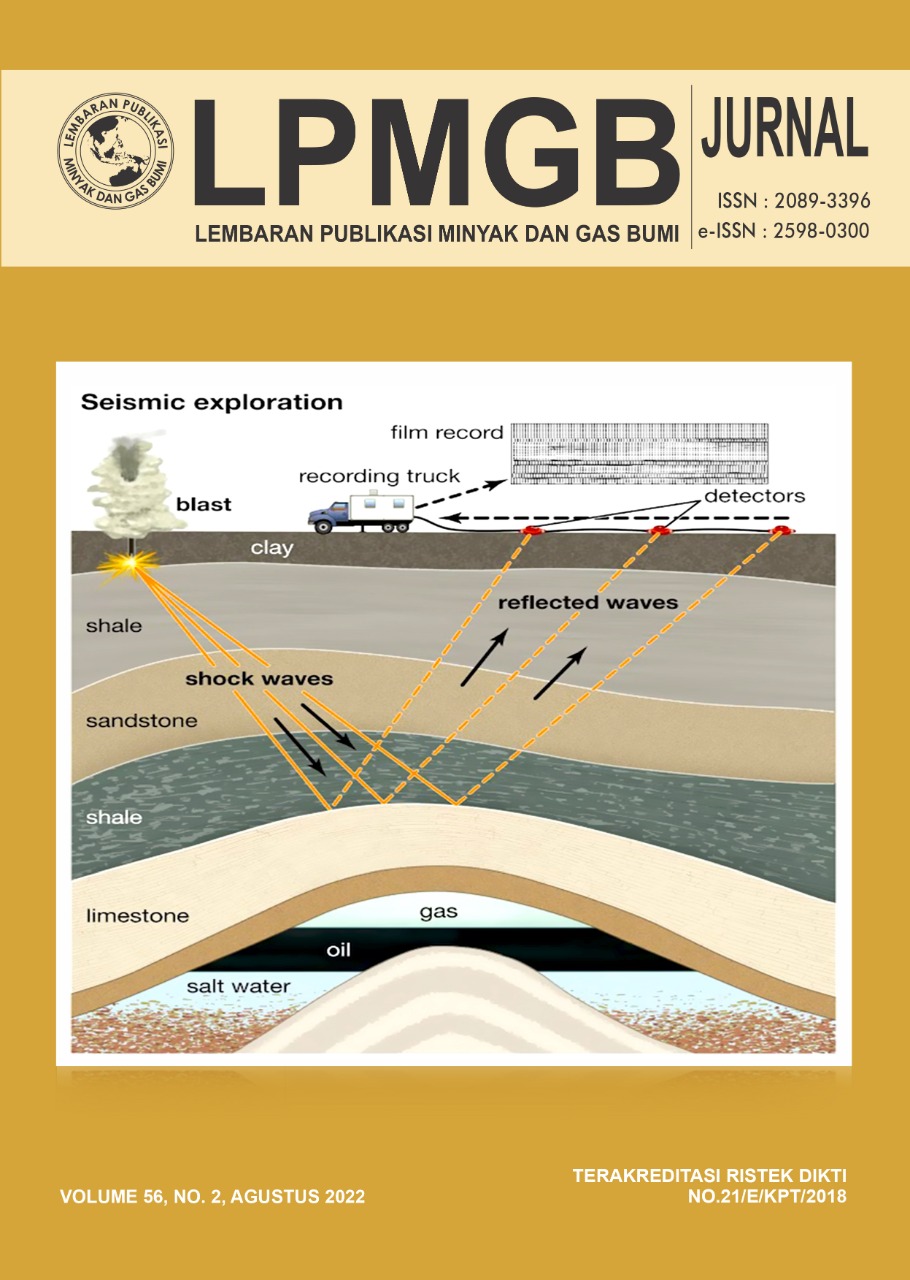PENGEMBANGAN METODE IDENTIFIKASI KARAKTERISTIK MINYAK BERAT HASIL EKSTRAKSI OIL SAND ILIRAN HIGH DENGAN FORMULA PERHITUNGAN BERDASARKAN KOMPOSISI ELEMENTER
DOI:
https://doi.org/10.29017/LPMGB.56.2.1174Kata Kunci:
Minyak Iliran High, Komposisi Elementer, Sifat Fisika, Sifat Kimia, Oil Sands, Iliran High Crude Oil, Elementary Composition, Characteristic Simulation, Physical Properties, Chemical PropertiesAbstrak
Sampai saat ini, minyak bumi masih memiliki peran strategis sebagai sumber energi bagi aktivitas kehidupan manusia. Akan tetapi, kebutuhan minyak bumi tidak diimbangi dengan cadangan yang ada. Oleh karena itu, minyak non-konvensional seperti minyak berat Iliran High perlu dikembangkan lebih jauh sebagai salah satu sumber cadangan minyak masa depan. Identifikasi sifat karakteristik minyak ini sangat penting karena menjadi tolok ukur mutu dan potensi umpan kilang minyak bumi. Namun identifikasi minyak hasil ekstraksi oil sand tidak mudah, karena sifatnya yang berat, sulit mengalir serta hasil (yield) yang sedikit. Minyak Iliran High diperoleh dengan mengekstrak oil sand menggunakan berbagai pelarut organik. Larutan hasil ekstraksi lalu dipisahkan dari padatan dengan proses filtrasi (penyaringan). Untuk merekoveri minyak dari pelarut dilakukan proses evaporasi sehingga diperoleh ekstrak berupa minyak berat dan rafinat (pelarut yang sudah tidak mengandung minyak) yang dapat digunakan kembali (diregenerasi) untuk proses ekstraksi selanjutnya. Kemudian dilakukan pengujian laboratorium untuk mengetahui specific gravity, gross heat value dan komposisi elementer. Berdasarkan data tersebut, dapat dilakukan identifikasi minyak berat Iliran High denfgan pendekatan rumus perhitungan untuk menentukan sifat karakteristik minyak berat seperti: rasio H/C, nilai kalor, bobot molekul, titik didih rerata, nilai faktor KUOP, titik anilin, titik tuang, viskositas, residu karbon, kandungan aspalten dan kadar aromatik. Karakterisasi minyak Iliran High menunjukkan komposisi elementer C, H, O, N dan S masing-masing sebesar 85,39 – 88,12%wt, 11,34 – 12,26%wt, 0,10 – 0,12%wt, 0 – 2,55%wt, dan >0,01%wt. Minyak Iliran High merupakan minyak berat, sweet crude dan dikategorikan sebagai minyak naftenik, dengan kadar aromatik ~40%.Â
Referensi
Augustin, C., Thomas Willner, and Anika
Sievers. 2014. “Estimating the Higher Heating
Value of Biomass Fuels of CVO and
HCVO Fuels from Elemental Analysis.†In
European Biomass Conference and Exhibition,
–91. https://doi.org/10.1016/j.
biombioe.2004.11.008.
Albahri, T. 2012. “Prediction of the aniline
point temperature of pure hydrocarbon
liqids and their mixture from molecular
structureâ€. Journal of Molecular Liquids,
, 80-85. https://doi.org/10.1016/j.molliq.
07.012.
British Petroleum. 2021. “BP Statistical Review
of World Energy 2021.†BP Energy
Outlook 2021. Vol. 70.
Fahim, M.A., T.A. Al-Sahhaf, and A.S. Elkilani.
Fundamentals of Petroleum
Refining. Elsevier.
Huda, M. 2014. “Development of new equations
for estimating gross calorific value
of Indonesian coalsâ€. Indonesian Mining
Journal, Vol. 17 No. 1, 10-19. http://dx.doi.
org/10.30556/imj.Vol17.No1.2014.340.
IHS Markit. 2021. “Energy Chemical Economics
Handbook.†2021. https://ihsmarkit.
com/products/energy-chemical-economics-
handbook.html.
Mansour, E. M., Desouky, S. M., El Aily, M.,
and Helmi, M. E. 2018. “The effect of asphaltene
content on predicting heavy dead
oils viscosity: experimental and modeling
studyâ€. Journal of Fuel, 212, 405-411.
https://doi.org/10.1016/j.fuel.2017.10.024.
Meyer, Richard F., Emil D. Attanasi, and
Philip A. Freeman. 2007. “Heavy Oil and
Natural Bitumen Resources in Geological
Basins of the World.†US Geological Survey.
Vol. 1084. http://pubs.usgs.gov/of/2007/.
Nie, F., He, D., Guan, J., Li, X., Hong, Y.,
Wang, L., Zheng, H., and Zhang Q, 2018.
“ Oil sand pyrolysis: evolution of volatiles
and contributions from mineral, bitumen,
maltene, and SARA fractionsâ€. Fuel, 224,
-739.
Pabon, R. E. C. and Filho, C. R de Souza.
“Crude oil spectral signatures and empirical
models to derive API gravityâ€. Journal
of Fuel, 237, 1119-1131. https://doi.org/
1016/j.fuel.2018.09.098.
Rannaveski, R. and Oja, V. 2020. “A new
thermogravimetric application of vapour pressure curve corresponding to average
boiling points of oil fractions with narrow
boiling rangesâ€. Journal of Thermochimica
Acta, 683, 178468. https://doi.org/10.1016/j.
tca.2019.178468.
Riazi, M. R. 2005. Characterization and Properties
of Petroleum Fractions. Barr Harbor:
ASTM International.
Ribeiro, Jorge Miguel Carneiro, Radu Godina,
João Carlos de Oliveira Matias, and
Leonel Jorge Ribeiro Nunes. 2018. “Future
Perspectives of Biomass Torrefaction:
Review of the Current State of the Art and
Research Development.†Sustainability 10
(7). https://doi.org/10.3390/su10072323.
Speight, James G. 1999. The Chemistry and
Technology of Petroleum. CRC Press.
Speight, James G. 2016. Handbook of Petroleum
Refining. London: CRC Press. https://
doi.org/10.1201/9781315374079-5.
Zheng, C., Zhu, M., Zarere, R, and Zhang,
D. 2018. “Characterisation of subfractions
of asphaltenes extracted from an oil sand using
NMR, DEPT and MALDI-TOFâ€. Journal
of Petroleum Science and Engineering,
, 148-155.

